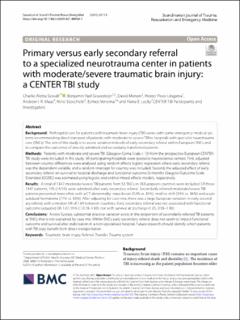| dc.contributor.author | Sewalt, Charlie | |
| dc.contributor.author | Gravesteijn, Benjamin | |
| dc.contributor.author | Menon, David | |
| dc.contributor.author | Lingsma, Hester F. | |
| dc.contributor.author | Maas, Andrew I. R. | |
| dc.contributor.author | Stocchetti, Nino | |
| dc.contributor.author | Venema, Esmee | |
| dc.contributor.author | Lecky, Fiona E. | |
| dc.contributor.author | Andelic, Nada | |
| dc.contributor.author | Andreassen, Lasse | |
| dc.contributor.author | Anke, Audny Gabriele Wagner | |
| dc.contributor.author | Frisvold, Shirin | |
| dc.contributor.author | Helseth, Eirik | |
| dc.contributor.author | Røe, Cecilie | |
| dc.contributor.author | Røise, Olav | |
| dc.contributor.author | Skandsen, Toril | |
| dc.contributor.author | Vik, Anne | |
| dc.contributor.author | Åkerlund, Cecilia | |
| dc.contributor.author | Amrein, Krisztina | |
| dc.contributor.author | Antoni, Anna | |
| dc.contributor.author | Audibert, Gerard | |
| dc.contributor.author | Azouvi, Philippe | |
| dc.contributor.author | Azzolini, Maria luisa | |
| dc.contributor.author | Bartels, Ronald | |
| dc.contributor.author | Barzo, Pal | |
| dc.contributor.author | Beauvais, Romuald | |
| dc.contributor.author | Beer, Ronny | |
| dc.contributor.author | Bellander, Bo-michael | |
| dc.contributor.author | Belli, Antonio | |
| dc.contributor.author | Benali, Habib | |
| dc.contributor.author | Berardino, Maurizio | |
| dc.contributor.author | Beretta, Luigi | |
| dc.contributor.author | Blaabjerg, Morten | |
| dc.contributor.author | Bragge, Peter | |
| dc.contributor.author | Brazinova, Alexandra | |
| dc.contributor.author | Brinck, Vibeke | |
| dc.contributor.author | Brooker, Joanne | |
| dc.contributor.author | Brorsson, Camilla | |
| dc.contributor.author | Buki, Andras | |
| dc.contributor.author | Bullinger, Monika | |
| dc.contributor.author | Cabeleira, Manuel | |
| dc.contributor.author | Caccioppola, Alessio | |
| dc.contributor.author | Calappi, Emiliana | |
| dc.contributor.author | Calvi, Maria rosa | |
| dc.contributor.author | Cameron, Peter | |
| dc.contributor.author | Lozano, Guillermo carbayo | |
| dc.contributor.author | Carbonara, Marco | |
| dc.contributor.author | Chevallard, Giorgio | |
| dc.contributor.author | Citerio, Giuseppe | |
| dc.contributor.author | Chieregato, Arturo | |
| dc.contributor.author | Cnossen, Maryse | |
| dc.date.accessioned | 2022-05-05T14:48:09Z | |
| dc.date.available | 2022-05-05T14:48:09Z | |
| dc.date.created | 2022-02-20T23:50:10Z | |
| dc.date.issued | 2021 | |
| dc.identifier.citation | Scandinavian Journal of Trauma, Resuscitation and Emergency Medicine. 2021, 29 (1), 1-11. | en_US |
| dc.identifier.issn | 1757-7241 | |
| dc.identifier.uri | https://hdl.handle.net/11250/2994418 | |
| dc.description.abstract | Background
Prehospital care for patients with traumatic brain injury (TBI) varies with some emergency medical systems recommending direct transport of patients with moderate to severe TBI to hospitals with specialist neurotrauma care (SNCs). The aim of this study is to assess variation in levels of early secondary referral within European SNCs and to compare the outcomes of directly admitted and secondarily transferred patients.
Methods
Patients with moderate and severe TBI (Glasgow Coma Scale < 13) from the prospective European CENTER-TBI study were included in this study. All participating hospitals were specialist neuroscience centers. First, adjusted between-country differences were analysed using random effects logistic regression where early secondary referral was the dependent variable, and a random intercept for country was included. Second, the adjusted effect of early secondary referral on survival to hospital discharge and functional outcome [6 months Glasgow Outcome Scale Extended (GOSE)] was estimated using logistic and ordinal mixed effects models, respectively.
Results
A total of 1347 moderate/severe TBI patients from 53 SNCs in 18 European countries were included. Of these 1347 patients, 195 (14.5%) were admitted after early secondary referral. Secondarily referred moderate/severe TBI patients presented more often with a CT abnormality: mass lesion (52% vs. 34%), midline shift (54% vs. 36%) and acute subdural hematoma (77% vs. 65%). After adjusting for case-mix, there was a large European variation in early secondary referral, with a median OR of 1.69 between countries. Early secondary referral was not associated with functional outcome (adjusted OR 1.07, 95% CI 0.78–1.69), nor with survival at discharge (1.05, 0.58–1.90).
Conclusions
Across Europe, substantial practice variation exists in the proportion of secondarily referred TBI patients at SNCs that is not explained by case mix. Within SNCs early secondary referral does not seem to impact functional outcome and survival after stabilisation in a non-specialised hospital. Future research should identify which patients with TBI truly benefit from direct transportation. | en_US |
| dc.language.iso | eng | en_US |
| dc.publisher | BMC | en_US |
| dc.rights | Navngivelse 4.0 Internasjonal | * |
| dc.rights.uri | http://creativecommons.org/licenses/by/4.0/deed.no | * |
| dc.title | Primary versus early secondary referral to a specialized neurotrauma center in patients with moderate/severe traumatic brain injury: a CENTER TBI study | en_US |
| dc.type | Peer reviewed | en_US |
| dc.type | Journal article | en_US |
| dc.description.version | publishedVersion | en_US |
| dc.source.pagenumber | 1-11 | en_US |
| dc.source.volume | 29 | en_US |
| dc.source.journal | Scandinavian Journal of Trauma, Resuscitation and Emergency Medicine | en_US |
| dc.source.issue | 1 | en_US |
| dc.identifier.doi | 10.1186/s13049-021-00930-1 | |
| dc.identifier.cristin | 2003855 | |
| cristin.ispublished | true | |
| cristin.fulltext | original | |
| cristin.qualitycode | 1 | |

